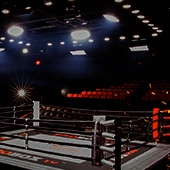By Tris Dixon
A FEW years ago I wrote a book called The Road to Nowhere.
It was a heck of a journey and had been almost a decade in the making.
At the start of the century I travelled to the USA to become a boxer.
I was not very good and would never have gone far, but I loved the sport.
After a couple of years of moving around the east coast I was on my way to train with Micky Ward in Lowell when I was contacted by Boxing News magazine.
They asked me to interview Micky (fresh off his victory over Arturo Gatti), and were pleased when I filed the story a few days later from the public library in Atlantic City, where I was living a few blocks back from the Boardwalk.
I was then asked, while I was in the USA, who I could meet and who else I could interview, and I soon found that the then Boxing News assistant editor Tony Connolly got a kick out of me telling him about the old fighters I had met on my travels.
That led to me traversing the USA on Greyhound buses for several months at a time trying to find fighters who either had not received the credit they were due or who had disappeared altogether.
In Philly, I met the likes of Buster Drayton, Kitten Hayward, Boogaloo Watts, Jimmy Young, Harold Johnson and Marvis Frazier. In New York I spent time with Jose Torres, in Atlantic City I was with Matthew Saad Muhammad and Dwight Qawi and in Connecticut I visited Chico Vejar. In Toronto I went up to see George Chuvalo, took the bus to Miami to meet Florentino Fernandez, saw Marvin Johnson in Indianapolis, Duane Bobick and Jim Beattie in Minneapolis, the Fullmer brothers (Gene and Don) in Salt Lake City, saw Eddie Mustafa Muhammad, Hedgemon Lewis and Joey Giambra in Vegas and then caught up with Aaron Pryor in Cincinnati and Ernie Terrell in Chicago.
There were many more fighters, many more cities, all done on a shoe-string budget.
It was hard, physically and mentally demanding.
I am sometimes asked today whether a sequel will ever be in the offing but that is unlikely.
There was, however, a period of time after I later joined Boxing News on the staff and subsequently became editor, when I would still pursue fighters whom we had not heard of in some time.
There was Irish Pat Murphy in New Jersey, Sammy Goss in Trenton, Alex Miteff in a New York care home, Eugene ‘Honey Bear’ Bryant in Las Vegas and former heavyweight champion Leroy Coldwell was also in Sin City.
On a work trip to Texas for Manny Pacquiao-Joshua Clottey I visited Curtis Cokes at his home and an early Muhammad Ali opponent, Donnie Fleeman in Red Oak.
Back on the east coast, I got to sit down and talk with Willie ‘The Worm’ Monroe, Darren ‘Checkmate’ Maciunski, tracked down former heavyweight contender Bert Cooper, Tyrell Biggs and Robert Hines.
They all had their stories to tell, but the circumstances of the interviews were far different. I was no longer a cub reporter trying to cut my teeth in the trade. I was in (cheap) rental cars, using sat navs and staying in (also cheap) hotels.
But it was not the same. The Road to Nowhere was a once-in-a-lifetime thing that I do not think I could replicate.
A big part of the story was the struggle to travel with next to no money and the kindness of the fighters who helped a kid with nothing. That took a certain level of commitment that only a man without children or responsibilities could really do.
Of course, as challenging as it was – and with hindsight how dangerous the journey was – there are no regrets. Those trips around the US are some of the best things I have done.
Many of the subjects have since died. Several are in poor health. I visited Northern State Prison to interview James Scott for the book. He has since been released but when ESPN recently attempted to interview him for a fascinating 30 for 30 podcast, he could not talk. Dementia had set in.
Others have declined in health. Too many are no longer here. Some of those I talked with have not done interviews since.
But it is important to remember, always, who paved the way for the fighters today.
So many think of Muhammad Ali, Mike Tyson, Sugar Ray Leonard and Floyd Mayweather and all of those A-listers. But often those in the opposite corner have stories of equal power, courage and colour.
They had their wins and losses, their successes and failures, but they are ultimately all an intrinsic part of the sport we love.


